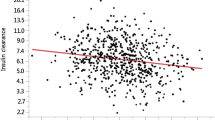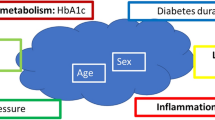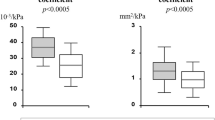Abstract
The aim of the present study was to evaluate the associations of ultrasonographic manifestations of carotid atherosclerosis with systolic (SBP) and diastolic blood pressure (DBP) and pulse pressure (PP) in 65-year-old Finns drawn from a population-based cohort. Carotid ultrasonographic measurements were performed on 54 diabetic subjects, 97 subjects with impaired glucose tolerance (IGT) and 57 normoglycaemic subjects (NGT). The subjects were classified into four quartiles of SBP, DBP and PP. SBP, DBP, PP and the use of antihypertensive drugs increased along with the deterioration of glucose status. The maximal intima-media thickness (IMT) of the common carotid artery (CCA) from the lowest to the highest quartiles of SBP was 0.98±0.34, 1.00±0.35, 1.03±0.29, 1.18± 0.52 mm (P=0.038), respectively. SBP was higher (161±22 mmHg) in the subjects with severe intima-media thickening (maximal IMT CCA ≥1.2 mm) than in those with maximal IMT CCA of <1.2 mm (153± 20 mmHg) (P=0.030). DBP and PP tended to be higher in the former than the latter group (DBP: 89±9 mmHg vs 86±9 mmHg, P=0.055 and PP: 72±18 mmHg vs 67±17 mmHg, P=0.159). The prevalence of severe intima-media thickening was 39% in the subjects in the highest SBP quartile (≥170 mmHg) and 20% in the subjects with lower SBP (P=0.008). In multiple regression analysis, the adjusted OR for severe intima-media thickening was 2.9 (95% CI 1.1–7.9) in the subjects in the highest SBP quartile compared to the subjects with lower SBP. In the present study, high SBP was associated with severe carotid intima-media thickening. We suggest that the results can be generalized to apply to elderly Finnish subjects with DM and IGT, but not to normoglycaemic subjects, on the basis of this study.
This is a preview of subscription content, access via your institution
Access options
Subscribe to this journal
Receive 12 digital issues and online access to articles
$119.00 per year
only $9.92 per issue
Buy this article
- Purchase on Springer Link
- Instant access to full article PDF
Prices may be subject to local taxes which are calculated during checkout
Similar content being viewed by others
References
Alexander RW . Hypertension and the pathogenesis of atherosclerosis: oxidative stress and the mediation of arterial inflammatory response: a new perspective. Hypertension 1995; 25: 155–161.
Chobanian AV, Alexander RW . Exacerbation of atherosclerosis by hypertension: potential mechanisms and clinical implications. Arch Intern Med 1996; 156: 1952–1956.
Stamler J, Stamler R, Neaton JD . Blood pressure, systolic and diastolic, and cardiovascular risks. Arch Intern Med 1993; 153: 598–615.
Kannel W . Blood pressure as a cardiovascular risk factor: prevention and treatment. JAMA 1996; 275: 1571–1576.
He J, Whelton PK . Elevated systolic blood pressure as a risk factor for cardiovascular and renal disease. J Hypertens 1999; 17 (Suppl 2): S7–S13.
Antikainen R, Jousilahti P, Tuomilehto J . Systolic blood pressure, isolated systolic hypertension and risk of coronary heart disease, strokes, cardiovascular disease and all-cause mortality in the middle-aged population. J Hypertens 1998; 16: 577–583.
Antikainen RL, Jousilahti P, Vanhanen H, Tuomilehto J . Excess mortality associated with increased pulse pressure among middle-aged men and women is explained by high systolic blood pressure. J Hypertens 2000; 18: 417–423.
Kannel W . Elevated systolic blood pressure as a cardiovascular risk factor. Am J Cardiol 2000; 85: 251–255.
Leonetti G, Cuspidi C, Facchini M, Stramba-Badiale M . Is systolic pressure a better target for antihypertensive treatment than diastolic pressure? J Hypertens 2000; 18 (Suppl 3): S13–S20.
Miura K et al. Pulse pressure compared with other blood pressure indexes in the prediction of 25-year cardiovascular and all-cause mortality rates: The Chicago Heart Association Detection Project in Industry Study. Hypertension 2001; 38: 232–237.
Franklin SS, Weber MA . Measuring hypertensive cardiovascular risk: the vascular overload concept. Am Heart J 1994; 128: 793–803.
Franklin SS et al. Hemodynamic patterns of age-related changes in blood pressure. The Framingham Heart Study. Circulation 1997; 96: 308–315.
Benetos A et al. Pulse pressure: a predictor of long-term cardiovascular mortality in a French male population. Hypertension 1997; 30: 1410–1415.
Benetos A, Rudnichi A, Safar M, Guize L . Pulse pressure and cardiovascular mortality in normotensive and hypertensive subjects. Hypertension 1998; 32: 560–564.
Domanski MJ et al. Isolated systolic hypertension: prognostic information provided by pulse pressure. Hypertension 1999; 34: 375–380.
Franklin SS et al. Is pulse pressure useful in predicting risk for coronary heart disease? The Framingham Heart Study. Circulation 1999; 100: 354–360.
Salonen R, Salonen JT . Determinants of carotid intima-media thickness: a population-based ultrasonography study in Eastern Finnish men. J Intern Med 1991; 229: 225–231.
Arnett DK et al. Hypertension and subclinical carotid artery atherosclerosis in blacks and whites: The Atherosclerosis Risk in Communities Study. Arch Intern Med 1996; 17: 1983–1989.
Bonithon-Kopp C et al. Relation of intima-media thickness to atherosclerotic plaques in carotid arteries: The Vascular Aging (EVA) Study. Arterioscler Thromb Vasc Biol 1996; 16: 310–316.
Lassila HC et al. Prevalence and determinants of carotid atherosclerosis in healthy postmenopausal women. Stroke 1997; 28: 513–517.
Rantala AO et al. Hyperinsulinemia and carotid atherosclerosis in hypertensive and control subjects. Diabetes Care 1998; 21: 1188–1193.
Lakka TA, Salonen R, Kaplan GA, Salonen JT . Blood pressure and the progression of carotid atherosclerosis in middle-aged men. Hypertension 1999; 34: 51–56.
Zureik M et al. Cross-sectional and 4-year longitudinal associations between brachial pulse pressure and common carotid intima-media thickness in a general population: the EVA Study. Stroke 1999; 30: 550–555.
Rajala U et al. Low insulin sensitivity measured by both quantitative insulin sensitivity check index and homeostasis model assessment method as a risk factor of increased intima-media thickness of the carotid artery. J Clin Endocrinol Metab 2002; 87: 5092–5097.
Rajala U, Keinänen-Kiukaanniemi S, Uusimäki A, Reijula K, Kivelä S.-L . Prevalence of diabetes mellitus and impaired glucose tolerance in a middle-aged Finnish population. Scand J Prim Health Care 1995; 13: 222–228.
Qiao Q et al. Risk for diabetes and persistent impaired glucose tolerance among middle-aged Finns. Diabetes Res Clin Pract 1996; 33: 191–198.
Rajala U, Qiao Q, Laakso M, Keinänen-Kiukaanniemi S . Antihypertensive drugs as predictors of Type 2 diabetes among subjects with impaired glucose tolerance. Diabetes Res Clin Pract 2000; 50: 231–239.
World Health Organization . Diabetes mellitus: report of a WHO Study Group. Technical Report Series No. 727. Geneva: World Health Organization, 1985.
Katz A et al. Quantitative insulin sensitivity check index: a simple, accurate method for assessing insulin sensitivity in humans. J Clin Endocrinol Metab 2000; 85: 2402–2410.
Hrebicek J et al. Detection of insulin resistance by simple quantitative insulin check index OUICKI for epidemiological assessment and prevention. J Clin Endocrinol Metab 2002; 87: 144–147.
SHEP Cooperative Research Group. Prevention of stroke by antihypertensive drug treatment in older persons with isolated systolic hypertension Final results of the Systolic Hypertension in the Elderly Program (SHEP). JAMA 1991; 265: 3255–3264.
Staessen JA et al., for the Systolic Hypertension in Europe (Syst-Eur) Trial Investigators. Randomised double-blind comparison of placebo and active treatment for older patients with isolated systolic hypertension. Lancet 1997; 350: 757–764.
Safar ME, Cloarec-Blanchard L, London GM . Arterial alterations in hypertension with a disproportionate increase in systolic over diastolic blood pressure. J Hypertens 1996; 14 (Suppl 2): S103–S110.
Glasser SP et al. Vascular compliance and cardiovascular disease. A risk factor or a marker? Am J Hypertens 1997; 10: 1175–1189.
Joint National Committee on Prevention, Detection, Evaluation, and Treatment of High Blood Pressure. The Sixth Report of the Joint National Committee on Prevention Detection, Evaluation, and Treatment of High Blood Pressure (JNC VI). Arch Intern Med 1997; 157: 2413–2446.
1999 World Health Organization – International Society of Hypertension. World Health Organization – International Society of Hypertension guidelines for the management of hypertension. Guidelines subcommittee. J Hypertens 1999; 17: 151–183.
Isomaa B et al. Cardiovascular morbidity and mortality associated with the metabolic syndrome. Diabetes Care 2001; 24: 683–689.
Salomaa V et al. Arterial disease/hypertension/angiotensin system: non-insulin-dependent diabetes mellitus and fasting glucose and insulin concentrations are associated with arterial stiffness indexes: the ARIC study. Circulation 1995; 91: 1432–1443.
van Popele NM et al. Association between arterial stiffness and atherosclerosis: The Rotterdam study. Stroke 2001; 32: 454–460.
Riley WA et al. Variation of common carotid artery elasticity with intimal-medial thickness: the ARIC study: Atherosclerosis Risk in Communities. Ultrasound Med Biol 1997; 23: 157–164.
Waddell TK et al. Carotid pressure is a better predictor of coronary artery disease severity than brachial pressure. Hypertension 2001; 38: 927–931.
Safar ME . Systolic blood pressure, pulse pressure and arterial stiffness as cardiovascular risk factors. Curr Opin Nephrol Hypertens 2001; 10: 257–261.
Khattar RS et al. Prediction of coronary and cere-brovascular morbidity and mortality by direct continuous ambulatory blood pressure monitoring in essential hypertension. Circulation 1999; 100: 1071–1076.
Khattar RS et al. Effect of ageing on the prognostic significance of ambulatory systolic, diastolic, and pulse pressure in essential hypertension. Circulation 2001; 104: 783–789.
Philippe F et al. Aortic pulse pressure and extent of coronary artery disease in percutaneous transluminal coronary angioplasty candidates. Am J Hypertens 2002; 15: 672–677.
Author information
Authors and Affiliations
Corresponding author
Rights and permissions
About this article
Cite this article
Rajala, U., Päivänsalo, M., Laakso, M. et al. Associations of blood pressure with carotid intima-media thickness in elderly Finns with diabetes mellitus or impaired glucose tolerance. J Hum Hypertens 17, 705–711 (2003). https://doi.org/10.1038/sj.jhh.1001594
Received:
Revised:
Accepted:
Published:
Issue Date:
DOI: https://doi.org/10.1038/sj.jhh.1001594
Keywords
This article is cited by
-
Omega-3 and Omega-6 Fatty Acids and Type 2 Diabetes
Current Diabetes Reports (2013)
-
Blood pressure and atherosclerotic plaques in carotid, aortic and femoral arteries in elderly Finns with diabetes mellitus or impaired glucose tolerance
Journal of Human Hypertension (2005)



